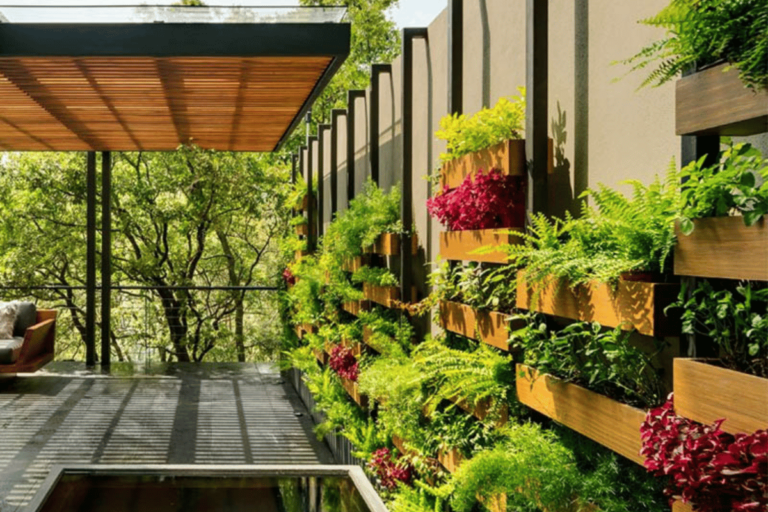Gains of Vertical Gardens
Vertical gardens are a contemporary style of bringing nature indoors and
saving space. They consist of plants grown upwards on a wall or any other
support structure. The significant advantage of having vertical gardens is that
they can improve indoor air quality. Plants absorb carbon dioxide and emit
oxygen, ensuring a healthier environment.
Improved Air Quality
These gardens can help filter pollutants and volatile organic compounds
(VOCs), which could be causing indoor air pollution. These make them
particularly helpful in city areas where air quality may not be up to standard.
The more plants you have, the better it will purify the air.
Example: Some common indoor plants like ferns, spider plants, and pothos are
very good at removing toxins such as formaldehyde, benzene, and
trichloroethylene from the air.
Space-Saving Design
Another critical advantage of vertical gardens is that they take up little
space. Small apartments, offices or urban environments with minimal horizontal
room space are ideal. By growing plants vertically, one can create greenery for
every room while saving on floor area.
Example: A vertical garden can fit into small spaces such as verandahs or
even kitchen walls, thus making maximum use of available space.
Aesthetic Appeal
Vertical gardens also bring aesthetic value by adding colour, texture and
natural beauty to walls. They act as live artworks that bring nature closer to
home.
Example: A living wall whole of different species of shrubs can be
eye-catching and form the centre of attraction in any room.
Mental Health and Well-Being
Having vertical gardens contributes towards improved mental health and
well-being. Research has shown that exposure to nature or greenery helps reduce
stress levels, lifts mood swings, and increases productivity. A vertical garden
within your house hold or workplace can create a calming and refreshing space,
encouraging relaxation and innovation.
Example: Employee satisfaction and productivity have improved in offices
with vertical gardens because of plants’ soothing presence.
How to Create a Vertical Garden
Setting up a vertical garden involves picking suitable plants, materials,
and installation methods. First, choose an appropriate site that has enough
light and is accessible for watering and maintenance. At the same time,
consider the specific lighting requirements for your desired plant species and
locate where this is possible.
Choosing the Right Location
Light Requirements: Choose a location that receives adequate light for your
target vegetation. It could be a bright room with many windows or an area with
access to grow lights.
Accessibility: Make sure it is easy to get to the location for watering
purposes or checking on it regularly.
Selecting a Vertical Garden System
Wall-Mounted Planters: These are easy to install and apply to various
patterns. They work best in small areas and can be customized according to your
taste preferences.
Modular Panels
These will allow you to change or add to your garden as you want since they
are flexible.
Hydroponic Systems – These are soil-less systems that use nutrient solutions
to grow crops, minimizing maintenance costs while maximizing growth potential.
They are ideal for people who want low-maintenance options.
Plants
Pick out plants that thrive in the conditions of your preferred location.
Some good examples of indoor vertical garden low-maintenance plants are pothos,
philodendrons, ferns and succulents. They are highly adaptable to the indoor
environment and withstand different lighting conditions.
Example: Succulents like echeveria and sedum are great for vertical gardens
as they require minimal water and care.
Installation
Arrange the plants to optimize their visibility and ensure that each plant
gets enough light and air circulation. Put up watering equipment so that water
is always available for the plants, even when you are not there. Regarding
vertical gardening, drip irrigation or self-watering systems are a blessing
since they guide water right at the base of plants while minimizing wastage due
to spillage.
Example: A drip irrigation system can be set up to automatically water your
plants, ensuring they receive the right amount of humidity without overwatering
them.
Maintenance
Monitor moisture levels regularly and adjust watering schedules accordingly.
At intervals, apply a balanced liquid fertilizer to encourage the healthy
growth of your plants.
Example: Check soil moisture content regularly using a moisture meter and
modify watering schedules accordingly; also fertilize plantings monthly
throughout the growing season to maintain healthful and robust growth.
Conclusion
Vertical gardens offer an innovative way of enhancing internal spaces and air
quality, promoting individual wellness. Choosing appropriate plants, materials,
and installation techniques enables the creation of beautiful, functional
vertical gardens that suit your space needs with the added advantage of
embracing nature, whether it is a home office or a small apartment.
Adopting this method has benefits, including having lively indoor spaces and making them
more environmentally friendly places where people can live comfortably.
Explore More Gardening Tips and Ideas
Source: Indoor Vertical Gardens


